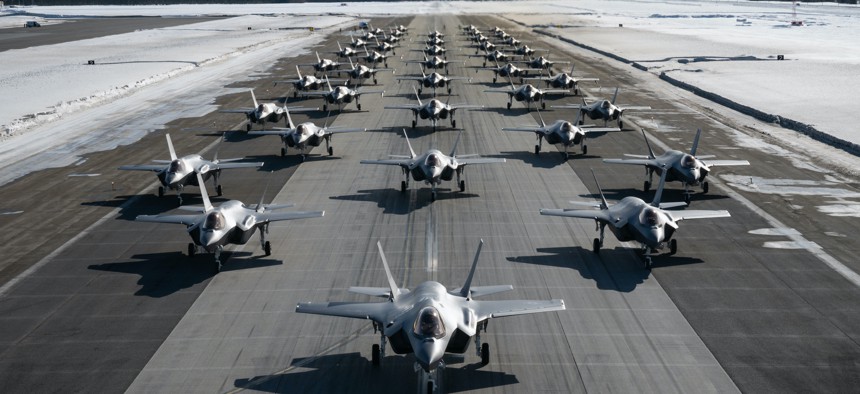
A formation of 42 F-35A Lightning IIs during a routine readiness exercise at Eielson Air Force Base, Alaska, March 25, 2022. U.S. Air Force / Airman 1st Class Jose Miguel T. Tamondong
Inflation Is the New Sequestration
Congress must shore up the Pentagon’s eroded buying power.
As the Pentagon asks Congress for $30 billion more for fiscal year 2023 over enacted appropriations for this year, inflation is at the center of a defense-spending battle brewing on Capitol Hill. It’s injecting uncertainty and risk in the Pentagon’s budgeting and planning. And it’s dividing lawmakers on the size of the defense budget just as global threats are on the rise.
Red-hot inflation makes America’s military poorer overnight. American servicemembers and their families are feeling the squeeze of inflation—last month, it hit nearly 8 percent— just like their fellow Americans out of uniform. Proposed to grow at just half the rate of inflation, the Pentagon’s budget will feel the squeeze as well. The proposed nominal 4.1 percent increase in the defense budget may have counted as generous in ordinary times. But these are not ordinary times.
The Pentagon’s comptroller recently claimed inflation’s impact on the Pentagon budget will be less severe than on the broader economy, though he acknowledged the Pentagon’s recent record of underestimating inflation. But no matter how “defense inflation” is calculated, the reality is clear: due to inflation and other cost pressures, each defense dollar is buying less capability to defend the nation than before.
That’s why Congress should use its oversight of the Pentagon’s forthcoming budget request to fully address the impact of inflation. As our colleagues John Ferrari and Elaine McCusker argue, Congress will have to root out inflation hidden by rosy economic assumptions and buck-passing in the form lower pay raises, shrinking procurement, and more. At the same time, Congress should recognize that the erosion of the Pentagon’s buying power is not a new phenomenon. And the recent spike in inflation is hardly its only cause.
Rising military personnel and operations and maintenance costs are producing “fact-of-life increases,” which former Deputy Defense Secretary Robert Work assesses “consistently rise faster than the rate of inflation.” Likewise, the Congressional Budget Office has documented repeatedly, the cost of simply doing defense business grows 2 to 8 percent (depending on the account) every single year. The result, as Arnold Punaro outlines in his latest book, is that taxpayers are currently spending more on defense in constant dollars than at the peak of the Reagan buildup, but for an active-duty military that is half the size.
Much of the decline in defense budget efficiency is the result of rising military personnel costs, which have more than doubled in the last 70 years after adjusting for inflation, according to CSIS’ Seamus Daniels. As personnel costs grow faster the defense budget, the Pentagon’s “must-pay” bills take up a greater share of the fiscal pie and diminish flexibility to allocate resources to other strategic priorities.
Beyond payroll, there’s also what could be described as “defense depreciation,” the declining value of the military’s inventory of combat capabilities over time. This depreciation imposes costs on the Defense Department. Just as a car’s value goes down the day it drives off the lot, a military platform, such as a fighter aircraft, begins to depreciate when fielded. The longer a fighter jet remains in the fleet, the more wear and tear it experiences, and the costlier it becomes to fly. As adversaries introduce new platforms and technologies of their own, the relative capability of the warplane is likely to decline—that is unless more money is spent to upgrade its sensors, weapons, or other enabling technologies so it can stay ahead of the threat.
This is not a recent phenomenon. In 1993, Dov Zakheim and Jeffrey Ranney cautioned defense planners dealing with the end of the Cold War that “realistic estimations of future DoD [operations and sustainment (O&S)] expenditures must begin [with] the recognition that O&S costs do, in fact, grow.” From 1954 to 1993, they found, DoD’s operations and maintenance costs grew in real terms at an annual compounded rate of 3.3 percent. From 1994 to 2021, those costs—adjusted for inflation and excluding the Defense Health Program—grew at an average rate of 1.7 percent.
Today, cost growth above inflation is still driven by factors identified by Zakheim and Ranney three decades ago, such as the “higher maintenance and support costs” of modern weapon systems relative to the forces they replace and “retention of major systems in service inventories longer and beyond their expected ‘design life’.”
Keeping old platforms longer, buying fewer new platforms to replace them, and overworking the older and smaller force that results is a formula for paying more for less and further widening the yawning gap between America’s defense strategy and resources.
Inflation, personnel costs, defense depreciation: these forces mean the Department of Defense needs real budget growth every year—not to increase America’s military capability, but simply to maintain it. Treading water hardly seems an acceptable level of ambition for America’s military when Russia is at war on NATO’s doorstep and China continues its military buildup. Yet even this may prove impossible if we do not address the inflation and cost growth eroding America’s defense buying power.
Mackenzie Eaglen is a resident fellow in the Marilyn Ware Center for Security Studies at the American Enterprise Institute. Dustin Walker is a nonresident fellow at the American Enterprise Institute and a former professional staff member on the Senate Armed Services Committee.






